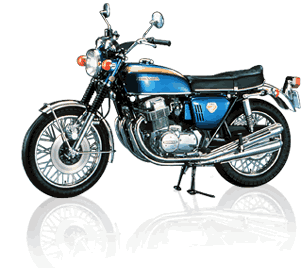
At my age, it’s rare to remember precisely what a photograph looked like when you saw it at 12 years old – it was, after all, 1968. An unofficial “spy” photo of a Honda CB 750. The massive engine with a small, Japanese test rider perched atop it. Was it like looking at a picture of the Suzuki Hayabusa, or the Kawasaki ZX-12 for the first time? No, nothing like that. Multiply that by ten times or, maybe better, 100 times. This was the impact on me as a young boy (young man?) as I saw that picture (and still see it in my mind today).
Fortunately, a friend of mine who lived on the “south side” of Montebello had a father who bought a new CB 750 a couple of years later and left the keys where we could find them. Moreover, Kent was crazy enough to put me on the back and ride off on the beast. Although familiar with motorcycles, neither of us was familiar with the sensations this marvel brought to us. Solid, massive, powerful and fast. Oh, and smooth in a way that motorcycles of its era were never smooth. So much power and so much grace.
That was then, and this is now (as they say). The 1969 Honda CB 750K is a quaint machine to those who view it out of context in the modern era of motorcycling. They will never understand how this bike affected people, from kids to seasoned motorcycle enthusiasts, when it was introduced to the world. This was a time when Honda was largely directed by the vision of its founder, and believed that things were possible when others didn’t.
There were other moments in my young life where I worshiped the two wheeled machines, including a few years later when my local Kawasaki dealer, Steve Hurd (who still works for Kawasaki to this day) showed me the new 750cc two-stroke triple, and I was awed by the successor to the 500cc two-stroke triple (a machine I had seen raced against the Honda 750 to a virtual dead heat on many occasions in front of my house). Having spent so many hours at his shop, he was kind enough to give me a ride on the machine and proceeded to wheelie the big 750 down the block with me seated behind (oh, of course, he told me to hold on tight – “lock your fingers”). He then demonstrated a “burn out” – although we called it “burning rubber” at the time.
Then, again, several years later, standing in the nearby Honda dealership, looking at the big, six cylinder CBX and dreaming about how fast it must be, and smooth. Kawasaki’s six-cylinder answer came soon, and I just knew motorcycling had reached its zenith.
The Bike of the Century isn’t really just one bike, although we will pick one below. The Bike of the Century is the bike that made each of you love motorcycles and ride them to fill a need that could never be completely filled.
Of course, the power and smoothness thing got improved considerably with time, as did everything else. The Kawasaki ZX-11 and, now, the Suzuki Hayabusa. Soon, the Kawasaki ZX-12. The bikes will always get faster and smoother, and maybe the adrenaline will flow harder, but while objectively better, subjectively the best bikes are those that impacted us when we were young (or, at least, young in the sport of motorcycling).
In the U.S., we may not have understood the style of Italian motorcycles until the Ducati 916 made us nod yes and understand. Moto Guzzi and its deep character, Laverda and its stonking three-cylinder Jota, and Bimota with its commitment to chassis perfection.
Harley-Davidson, Indian, and other historical American marques with their sometimes crude, but direct and effective engineering, endeared themselves to many of us.
The British parallel twins, such as Norton, Triumph and BSA, despite their not infrequent mechanical failures, won us over with their direct and simple approach to performance and handling — and style. They embodied the essence of a motorcycle; function as beauty.
I hope we made you think about the bikes in your personal history that were important to you. Now, since we have to pick a single bike as Bike of the Century, we choose the Honda CB 750 (also the highest vote-getter in our e-mail poll). This bike, at least arguably, made the largest single step forward in technology, performance, and design of any motorcycle in the history of motorcycling. Besides that, it took Kent and me to 100 miles per hour on Vail Avenue in Montebello on a cold, overcast morning in 1970.





